Potassium Stearate: A Versatile Anionic Surfactant for Industrial Applications
Discover the key properties and diverse industrial uses of potassium stearate, from rubber vulcanization to personal care formulations.
Get a Quote & SampleProduct Core Value

Potassium Stearate
Potassium stearate is a white, fluffy powder characterized by a fatty odor and its classification as an anionic surfactant. It demonstrates exceptional performance, particularly in rubber vulcanization systems, where it acts as a crucial synergist. Its ability to neutralize acidic byproducts and enhance cross-linking efficiency significantly improves the tensile strength of vulcanized rubber, while also reducing energy consumption during mixing.
- Discover the benefits of potassium stearate rubber vulcanization as a key component in advanced rubber formulations.
- Leverage potassium stearate as an anionic surfactant for acrylate rubber to achieve superior material properties.
- Utilize its excellent surface activity to regulate vulcanization properties effectively during rubber processing.
- Explore its potential applications in various scenarios requiring potent anionic surfactants, ensuring optimal performance.
Key Advantages Offered
Enhanced Rubber Properties
Potassium stearate boosts the tensile strength of vulcanized rubber by 10–15% and accelerates vulcanization when paired with zinc oxide, making it ideal for demanding applications.
Versatile Industrial Applications
Beyond rubber, it functions as an emulsion stabilizer in water-based paints, a pigment dispersant in inks, and an antistatic agent in textiles, showcasing its broad utility.
Improved Processing Efficiency
This industrial grade potassium stearate reduces mixing friction in rubber production, leading to a 10–12% decrease in energy consumption and improving overall process efficiency.
Key Applications
Rubber Industry
As a core synergist for vulcanization, potassium stearate stabilizes soap/sulfur systems and enhances cross-linking efficiency.
Coatings & Inks
Acts as an emulsion stabilizer in water-based acrylic paints and disperses pigments effectively in printing inks.
Textiles
Forms an antistatic film on synthetic fibers, reducing surface resistance and promoting even dye penetration.
Metal Processing
Provides lubrication in metal cutting fluids, reducing friction and cutting temperatures, thereby extending tool life.
Related Technical Articles & Resources
Why Choose Us?
Leverage our expertise and state-of-the-art infrastructure to accelerate your journey from discovery to commercial success.
Global Experience
With 20 years of R&D, manufacturing, and sales experience, we proudly serve clients across 60 countries and regions worldwide.
Advanced Facilities
Our in-house R&D laboratory, pilot platform, and large-scale production workshop are equipped to meet the audit requirements of global customers.
Seamless Scalability
We facilitate a perfect transition from small-scale lab requirements (grams) to full commercialization (hundreds of tons).
